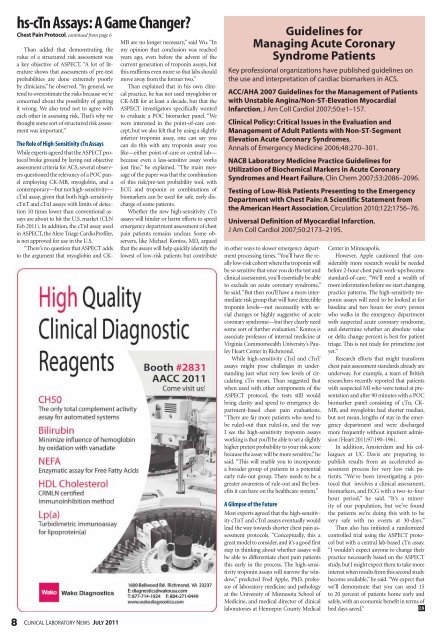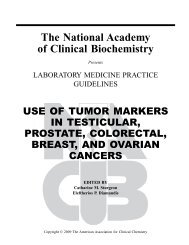Download the entire issue - American Association for Clinical ...
Download the entire issue - American Association for Clinical ...
Download the entire issue - American Association for Clinical ...
You also want an ePaper? Increase the reach of your titles
YUMPU automatically turns print PDFs into web optimized ePapers that Google loves.
hs-cTn Assays: A Game Changer?<br />
chest Pain Protocol, continued from page 6<br />
Than added that demonstrating <strong>the</strong><br />
value of a structured risk assessment was<br />
a key objective of ASPECT. “A lot of literature<br />
shows that assessments of pre-test<br />
probabilities are done extremely poorly<br />
by clinicians,” he observed. “In general, we<br />
tend to overestimate <strong>the</strong> risks because we’re<br />
concerned about <strong>the</strong> possibility of getting<br />
it wrong. We also tend not to agree with<br />
each o<strong>the</strong>r in assessing risk. That’s why we<br />
thought some sort of structured risk assessment<br />
was important.”<br />
The Role of High-Sensitivity cTn Assays<br />
While experts agreed that <strong>the</strong> ASPECT protocol<br />
broke ground by laying out objective<br />
assessment criteria <strong>for</strong> ACS, several observers<br />
questioned <strong>the</strong> relevancy of a POC panel<br />
employing CK-MB, myoglobin, and a<br />
contemporary—but not high-sensitivity—<br />
cTnI assay, given that both high-sensitivity<br />
cTnT and cTnI assays with limits of detection<br />
10 times lower than conventional assays<br />
are about to hit <strong>the</strong> U.S. market (CLN<br />
Feb 2011). In addition, <strong>the</strong> cTnI assay used<br />
in ASPECT, <strong>the</strong> Alere Triage CardioProfiler,<br />
is not approved <strong>for</strong> use in <strong>the</strong> U.S.<br />
“There’s no question that ASPECT adds<br />
to <strong>the</strong> argument that myoglobin and CK-<br />
8 CliniCal laboratory news July 2011<br />
MB are no longer necessary,” said Wu. “In<br />
my opinion that conclusion was reached<br />
years ago, even be<strong>for</strong>e <strong>the</strong> advent of <strong>the</strong><br />
current generation of troponin assays, but<br />
this reaffirms even more so that labs should<br />
move away from <strong>the</strong> <strong>for</strong>mer two.”<br />
Than explained that in his own clinical<br />
practice, he has not used myoglobin or<br />
CK-MB <strong>for</strong> at least a decade, but that <strong>the</strong><br />
ASPECT investigators specifically wanted<br />
to evaluate a POC biomarker panel. “We<br />
were interested in <strong>the</strong> point-of-care concept,<br />
but we also felt that by using a slightly<br />
inferior troponin assay, one can say you<br />
can do this with any troponin assay you<br />
like—ei<strong>the</strong>r point-of-care or central lab—<br />
because even a less-sensitive assay works<br />
just fine,” he explained. “The main message<br />
of <strong>the</strong> paper was that <strong>the</strong> combination<br />
of this risk/pre-test probability tool, with<br />
ECG and troponin or combinations of<br />
biomarkers can be used <strong>for</strong> safe, early discharge<br />
of some patients.<br />
Whe<strong>the</strong>r <strong>the</strong> new high-sensitivity cTn<br />
assays will hinder or harm ef<strong>for</strong>ts to speed<br />
emergency department assessment of chest<br />
pain patients remains unclear. Some observers,<br />
like Michael Kontos, MD, argued<br />
that <strong>the</strong> assays will help quickly identify <strong>the</strong><br />
lowest of low-risk patients but contribute<br />
Guidelines <strong>for</strong><br />
managing acute coronary<br />
syndrome Patients<br />
Key professional organizations have published guidelines on<br />
<strong>the</strong> use and interpretation of cardiac biomarkers in aCs.<br />
acc/aha 2007 Guidelines <strong>for</strong> <strong>the</strong> management of Patients<br />
with unstable angina/non-sT-elevation myocardial<br />
infarction, J am Coll Cardiol 2007;50:e1–157.<br />
clinical Policy: critical <strong>issue</strong>s in <strong>the</strong> evaluation and<br />
management of adult Patients with non-sT-segment<br />
elevation acute coronary syndromes,<br />
annals of emergency Medicine 2006;48:270–301.<br />
nacb laboratory medicine Practice Guidelines <strong>for</strong><br />
utilization of biochemical markers in acute coronary<br />
syndromes and heart failure, Clin Chem 2007;53:2086–2096.<br />
Testing of low-risk Patients Presenting to <strong>the</strong> emergency<br />
department with chest Pain: a scientific statement from<br />
<strong>the</strong> american heart association, Circulation 2010;122;1756–76.<br />
universal definition of myocardial infarction,<br />
J am Coll Cardiol 2007;50:2173–2195.<br />
in o<strong>the</strong>r ways to slower emergency department<br />
processing times. “You’ll have <strong>the</strong> really<br />
low-risk cohort where <strong>the</strong> troponin will<br />
be so sensitive that once you do <strong>the</strong> test and<br />
clinical assessment, you’ll essentially be able<br />
to exclude an acute coronary syndrome,”<br />
he said. “But <strong>the</strong>n you’ll have a more intermediate<br />
risk group that will have detectible<br />
troponin levels—not necessarily with serial<br />
changes or highly suggestive of acute<br />
coronary syndrome—but <strong>the</strong>y clearly need<br />
some sort of fur<strong>the</strong>r evaluation.” Kontos is<br />
associate professor of internal medicine at<br />
Virginia Commonwealth University’s Pauley<br />
Heart Center in Richmond.<br />
While high-sensitivity cTnI and cTnT<br />
assays might pose challenges in understanding<br />
just what very low levels of circulating<br />
cTn mean, Than suggested that<br />
when used with o<strong>the</strong>r components of <strong>the</strong><br />
ASPECT protocol, <strong>the</strong> tests still would<br />
bring clarity and speed to emergency department-based<br />
chest pain evaluations.<br />
“There are far more patients who need to<br />
be ruled-out than ruled-in, and <strong>the</strong> way<br />
I see <strong>the</strong> high-sensitivity troponin assays<br />
working is that you’ll be able to set a slightly<br />
higher pretest probability to your risk score<br />
because <strong>the</strong> assay will be more sensitive,” he<br />
said. “This will enable you to incorporate<br />
a broader group of patients in a potential<br />
early rule-out group. There needs to be a<br />
greater awareness of rule-out and <strong>the</strong> benefits<br />
it can have on <strong>the</strong> healthcare system.”<br />
A Glimpse of <strong>the</strong> Future<br />
Most experts agreed that <strong>the</strong> high-sensitivity<br />
cTnT and cTnI assays eventually would<br />
lead <strong>the</strong> way towards shorter chest pain assessment<br />
protocols. “Conceptually, this a<br />
great model to consider, and it’s a good first<br />
step in thinking about whe<strong>the</strong>r assays will<br />
be able to differentiate chest pain patients<br />
this early in <strong>the</strong> process. The high-sensitivity<br />
troponin assays will narrow <strong>the</strong> window,”<br />
predicted Fred Apple, PhD, professor<br />
of laboratory medicine and pathology<br />
at <strong>the</strong> University of Minnesota School of<br />
Medicine, and medical director of clinical<br />
laboratories at Hennepin County Medical<br />
Center in Minneapolis.<br />
However, Apple cautioned that considerably<br />
more research would be needed<br />
be<strong>for</strong>e 2-hour chest pain work-ups become<br />
standard-of-care. “We’ll need a wealth of<br />
more in<strong>for</strong>mation be<strong>for</strong>e we start changing<br />
practice patterns. The high-sensitivity troponin<br />
assays will need to be looked at <strong>for</strong><br />
baseline and two hours <strong>for</strong> every person<br />
who walks in <strong>the</strong> emergency department<br />
with suspected acute coronary syndrome,<br />
and determine whe<strong>the</strong>r an absolute value<br />
or delta change percent is best <strong>for</strong> patient<br />
triage. This is not ready <strong>for</strong> primetime just<br />
yet.”<br />
Research ef<strong>for</strong>ts that might trans<strong>for</strong>m<br />
chest pain assessment standards already are<br />
underway. For example, a team of British<br />
researchers recently reported that patients<br />
with suspected MI who were tested at presentation<br />
and after 90 minutes with a POC<br />
biomarker panel consisting of cTn, CK-<br />
MB, and myoglobin had shorter median,<br />
but not mean, lengths of stay in <strong>the</strong> emergency<br />
department and were discharged<br />
more frequently without inpatient admission<br />
(Heart 2011;97:190–196).<br />
In addition, Amsterdam and his colleagues<br />
at UC Davis are preparing to<br />
publish results from an accelerated assessment<br />
process <strong>for</strong> very low risk patients.<br />
“We’ve been investigating a protocol<br />
that involves a clinical assessment,<br />
biomarkers, and ECG with a two-to-four<br />
hour period,” he said. “It’s a minority<br />
of our population, but we’ve found<br />
<strong>the</strong> patients we’re doing this with to be<br />
very safe with no events at 30-days.”<br />
Than also has initiated a randomized<br />
controlled trial using <strong>the</strong> ASPECT protocol<br />
but with a central lab-based cTn assay.<br />
“I wouldn’t expect anyone to change <strong>the</strong>ir<br />
practice necessarily based on <strong>the</strong> ASPECT<br />
study, but I might expect <strong>the</strong>m to take more<br />
interest when results from this second study<br />
become available,” he said. “We expect that<br />
we’ll demonstrate that you can send 15<br />
to 20 percent of patients home early and<br />
safely, with an economic benefit in terms of<br />
bed days saved.” CLN
















